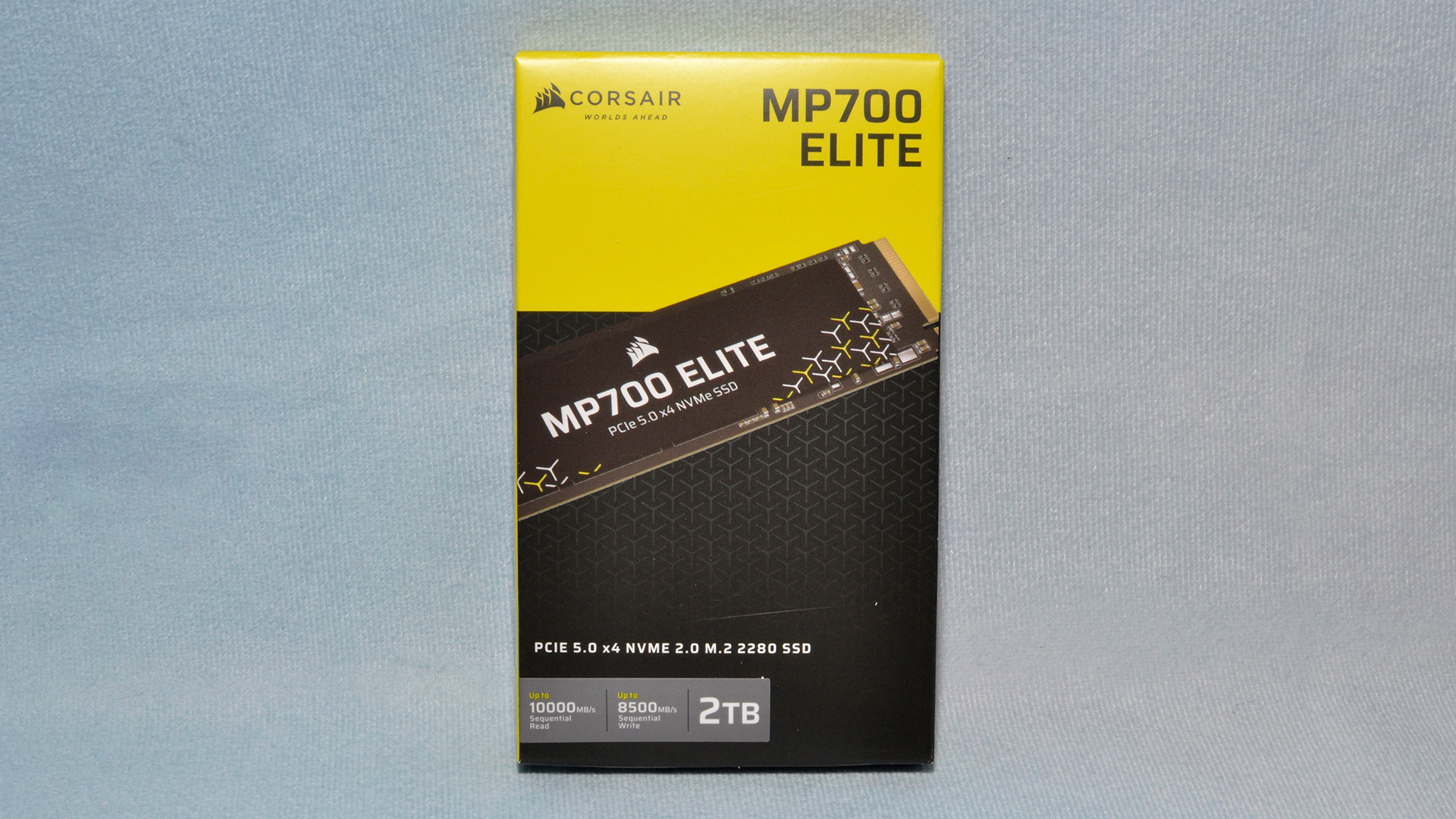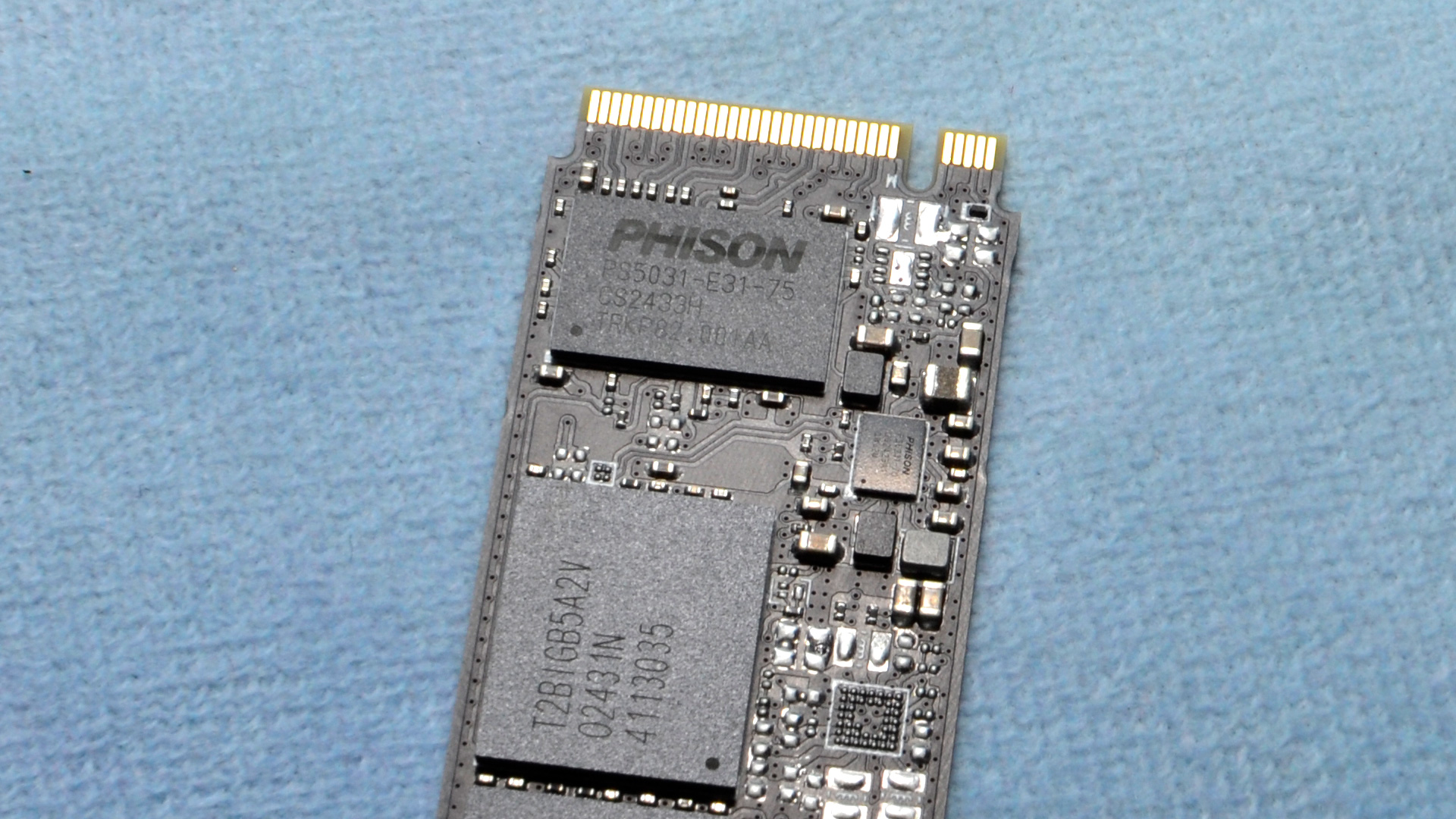Tom's Hardware Verdict
The Corsair MP700 Elite is the kind of drive we want to see, leveraging cutting-edge technology to provide unprecedented performance and efficiency for a PCIe 5.0 SSD, without the need for a heatsink.
Pros
- +
Good all-around performance
- +
High power efficiency
- +
Relatively cool-running
Cons
- -
Limited capacity options
Why you can trust Tom's Hardware
The Corsair MP700 Elite delivers on the possibilities promised in our Phison E31T preview. It's one of the first of what will surely be many retail products using the controller and NAND combination. Most importantly, it's here now and you can hold it in your hands — or put it into a PC where it belongs. The Corsair MP700 Elite comes from a combination of efforts, with Phison delivering a production 7nm 'N7' SSD controller and Kioxia via its high-speed BiCS8 flash. The result is a powerful, efficient, and optimistic sign of things to come in the storage space.
The MP700 Elite is an exciting product not only because it treads new ground, but because it does it simply and effectively. Corsair is sticking to the most popular capacities and keeping the heatsink as an option. It's a continuation of the company’s SSD strategy of focusing on what sells well, combined with getting new technology out to the public as early as possible. There's room for some improvements with the follow-through, particularly in getting the website updated, getting stock to resellers more quickly, and setting drive prices at a reasonable place in a more timely fashion. But Corsair has generally nailed getting the right products out there, and it just needs to do that more smoothly.
We'll see many more drives like the MP700 Elite from competitors, including the contemporaneous Addlink G55 that's also on our testbench. Corsair comes with a reputable brand name and a willingness to stay relevant in the SSD market. We think this technology is the future as it combines high performance with high power efficiency in a svelte, single-sided design. There’s little not to like about the MP700 Elite, although it doesn’t quite fulfill all storage roles and we’d like to see a 4TB SKU.
Corsair MP700 Elite Specifications
| Product | 1TB | 2TB |
|---|---|---|
| Pricing | $149.99 | $249.99 |
| Form Factor | M.2 2280 SS | M.2 2280 SS |
| Interface / Protocol | PCIe 5.0 x4 / NVMe 2.0 | PCIe 5.0 x4 / NVMe 2.0 |
| Controller | Phison E31T | Phison E31T |
| DRAM | N/A (HMB) | N/A (HMB) |
| Flash Memory | Kioxia 218-Layer (BiCS8) TLC | Kioxia 218-Layer (BiCS8) TLC |
| Sequential Read | 10,000 MB/s | 10,000 MB/s |
| Sequential Write | 8,500 MB/s | 8,500 MB/s |
| Random Read | 1,300K IOPS | 1,300K IOPS |
| Random Write | 1,400K IOPS | 1,400K IOPS |
| Security | TCG Pyrite | TCG Pyrite |
| Dimensions | 22mm x 80mm x 2mm 24mm x 80mm x 9mm (HS) | 22mm x 80mm x 2mm 24mm x 80mm x 9mm (HS) |
| Endurance (TBW) | 600TB | 1,200TB |
| Security | TCG Pyrite | TCG Pyrite |
| Part Number | CSSD-F1000GBMP700ENH CSSD-F1000GBMP700EHS | CSSD-F2000GBMP700ENH CSSD-F2000GBMP700EHS |
| Warranty | 5-Year | 5-Year |
Corsair focused on the most popular capacities with the MP700 Elite launch, only offering the drive at 1TB and 2TB capacities — at least for now. There have been increasing calls for 4TB drives in recent months from storage enthusiasts, and those make the most sense for high-end products like the Samsung 990 Pro. Of course, the MP700 Elite isn't remotely what we'd classify as a budget drive and in fact qualifies as a high-end offering, but current flash isn't dense enough to make 4TB optimal for the four-channel SSD controller used here, not that it’s prevented such drives from existing and even being popular.
The market right now still has 2TB as the sweet spot, and Corsair is focusing on delivering that with a cutting-edge drive like the MP700 Elite. Corsair didn’t provide official pricing for this drive prior to launch, but it’s already showing up at some vendors with prices of $149.99 for 1TB and $249.99 for 2TB. Those prices feel absurdly high even for a drive of this quality, and we expect street prices will be significantly lower considering they aren’t too far off the MP700 Pro — which costs $279 for 2TB and $165 for 1TB at present.
The drive’s specifications closely match the Phison E31T engineering sample we previously previewed. The MP700 Elite can hit up to 10,000 / 8,500 MB/s for sequential reads and writes and up to 1,300K / 1,400K random read and write IOPS. These performance targets are identical for both 1TB and 2TB models, which means you’re not giving anything beyond capacity up by sticking with the smaller SKU. The warranty is standard at five years with up to 600TB of writes per TB capacity.
Corsair MP700 Elite Software and Accessories
The primary download for Corsair SSDs is the Corsair SSD Toolbox. It provides a single application with a variety of functionality, allowing you to verify drive health, search for firmware updates, secure erase the drive, backup data, clone a drive, and more. The quality of the toolbox varies from manufacturer to manufacturer — if they even offer one — with Corsair’s being one of the better options. Corsair’s been in the SSD business for quite a while, so its name is more well-known and having an SSD toolbox helps reinforce that brand. If software and updates are important to you, this is a selling point.
Corsair MP700 Elite: A Closer Look





The MP700 Elite is, unsurprisingly, single-sided. This makes it ideal for laptops and other devices that only accept single-sided drives, and it can also make the drive easier to cool. Nevertheless, Corsair offers a heatsink version of the drive if that’s your thing. The heatsink is aluminum and increases the width from 22mm to 24mm and height or thickness from 2mm to 9mm, so make sure your system can handle that if you go that route.
The heatsink should be extremely effective for a drive like this, one that already runs generally cool. Even though the label suggests up to 7.26W of power draw — 3.3V and 2.2A — the spec sheet pegs this drive at less than 6W at peak, which is about half that of the high-end PCIe 5.0 SSDs.


Peeling back the label reveals Kioxia 218-Layer BiCS8 TLC flash, the same we found on the 2TB E31T ES. Each NAND package offers 1TB of capacity, made up of eight 1Tb dies. Potentially the packages could be arranged to allow four per side, but the current layout would only allow for a 4TB single-sided drive with sixteen dies per package.
The controller is also the same E31T (the "T" suffix is for DRAM-less Phison controllers), this one manufactured during week 33 of this year. We discussed this hardware in some depth in our ES preview. If you have a drive with the Phison E21T or E27T controller, you more or less know what you’re getting here. The difference is that this one is manufactured using TSMC's N7 process node, which allows it to push higher speeds with lower power usage. And of course, this controller supports PCIe 5.0 where those others are PCIe 4.0 models.
MORE: Best SSDs
MORE: How We Test HDDs And SSDs
Get Tom's Hardware's best news and in-depth reviews, straight to your inbox.
MORE: All SSD Content
- 1
- 2
Current page: Corsair MP700 Elite Features and Specifications
Next Page Corsair MP700 Elite 2TB Performance Results
Shane Downing is a Freelance Reviewer for Tom’s Hardware US, covering consumer storage hardware.
-
phxrider What am I missing? From what I see, it's barely faster than the PCIe 4 drives, and more expensive. Actually, it's even more expensive than the higher end, better performing Teamgroup 540.Reply -
Mama Changa Reply
Well, the author did say prices were way too high.phxrider said:What am I missing? From what I see, it's barely faster than the PCIe 4 drives, and more expensive. Actually, it's even more expensive than the higher end, better performing Teamgroup 540.
I'd get the T500 ahead of this. -
Maxxify Reply
682.4 MB/s per watt. This is over 50% more efficient than the 2TB Gold P31, if that puts things into perspective.HideOut said:all th is talk about power effeciency, and no graphs or other data to suppport it? -
Stomx Reply
When older gen 4.0 drives deliver 7+ GB/s this one with 8.5 does not look particularly attractivephxrider said:What am I missing? From what I see, it's barely faster than the PCIe 4 drives, and more expensive. Actually, it's even more expensive than the higher end, better performing Teamgroup 540. -
bit_user Reply
I'd like to know how well it does when limited to PCIe 4.0 or 3.0 speeds. There are plenty of systems out there that only support up to PCIe 3.0 and the P31 Gold is a PCIe 3.0 drive.Maxxify said:682.4 MB/s per watt. This is over 50% more efficient than the 2TB Gold P31, if that puts things into perspective. -
bit_user Reply
What I find more alarming is the QD1 read performance vs. block size:Stomx said:When older gen 4.0 drives deliver 7+ GB/s this one with 8.5 does not look particularly attractive
The graph doesn't say, but I'm assuming this is random reads. It falls way behind after 4k and doesn't really catch up until 1M.
I'd also like to see how random read performance scales vs. queue depth at 4k, 64k, and 1M sizes. If we had that, we wouldn't need the bar charts showing the same data points.
I think less emphasis could be placed on write benchmarking. Obviously, there needs to be some, but why do I care about peak sequential write at QD8? Who would do that? Why? And do you not see that graph is almost exactly the same as the peak sequential write at QD1?
@JarredWaltonGPU -
Maxxify Reply
Should be even more efficient. Would be cool to see it tested at lower PCIe speeds.bit_user said:I'd like to know how well it does when limited to PCIe 4.0 or 3.0 speeds. There are plenty of systems out there that only support up to PCIe 3.0 and the P31 Gold is a PCIe 3.0 drive. -
bit_user Reply
Yeah, I wouldn't be surprised if it were more efficient, but I really don't know how much of its efficiency advantage comes from higher speeds vs. lower power. That's why I'm wondering.Maxxify said:Should be even more efficient. Would be cool to see it tested at lower PCIe speeds.
FWIW, I find bandwidth per Watt a slightly weird metric, when buying a drive for personal use. I care about performance and power. However, depending on what I'm doing, I'll tend to prioritize one above the other. If it's for a gaming desktop, I'd care about performance first and I'd probably only use power as a tie-breaker. For something like a laptop, I'd prioritize power but probably not to extent that I'd accept a major performance tradeoff.
You could have two drives with virtually identical perf/W, but very different performance and power levels. I think the metric is basically useless, outside of datacenter applications. Even then, what you'd probably rather see is the number of Joules required to complete a defined workload. -
snapdragon-x Where is the Addlink G55 review? So, it's essentially the same product? It's 25% less expensive than the Corsair one where I live.Reply